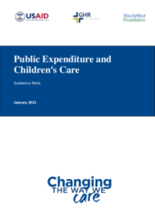This guidance is designed to strengthen the capacity of government agencies in low resource settings to prepare a sound budgetary framework for policies, programs and services that aim to keep children in safe and nurturing family environments. It further outlines a methodology for making the investment case for a family-focused continuum of care to the broader government, development partners and external donors.
The primary audience for this guidance is public officials and those that support their work, especially those responsible for policy and budgeting in the social and justice sectors with the mandate to improve the care and protection of children in their countries. It is also designed to be accessible to those organizations working with governments to develop and implement policies to improve children’s care arrangements. This is not a training in the field of public expenditure, and the reader is assumed to have some knowledge of how public expenditure systems work.
This guidance focuses exclusively on public expenditure. It should be noted that in many low resource countries, private donors also provide funding for children’s care across an array of programs and services.
The rights of children to live in a family environment are elaborated in a December 2019 U.N. General Assembly Resolution on the Rights of the Child, and are further specified in the U.N. Convention on the Rights of the Child, the Convention on the Rights of Persons With Disabilities, the U.N. Guidelines on the Alternative Care of Children, and other global and regional conventions and instruments. UNICEF and 265 non-governmental organizations have endorsed a package of ‘Key Recommendations’ on how to implement the provisions of the December 2019 Resolution on the Rights of the Child.
Budgeting for care reform has never been more critical than during the COVID-19 pandemic. Guidance has been produced by the International Monetary Fund on how to best budget under the challenging and volatile circumstances presented by the pandemic. This will have an important bearing on how those budgeting for care reform will need to approach the budget cycle in the future.
Read the accompanying Children's Care and the National Budget technical brief.
Read the report on public expenditure in Guatemala here.
View the recording of the webinar presentation of this guidance note here.

